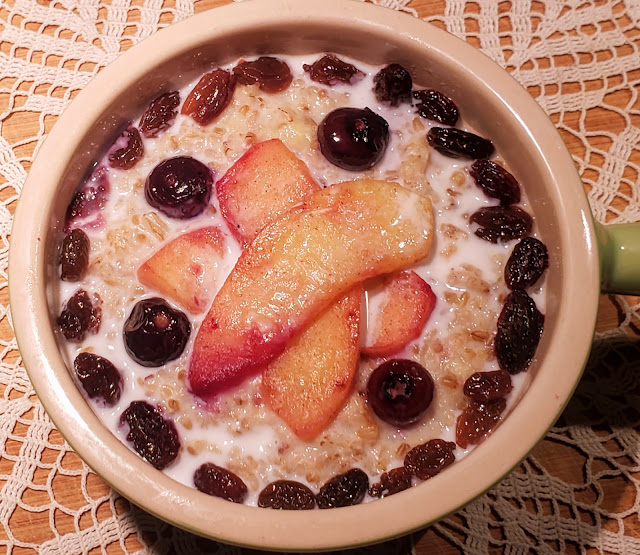Charlotte Brontë, (Born 21 April 1816 - Died 31 March 1855)
Portrait by George Richmond, 1850, chalk
National Portrait Gallery, London
Brontë's publisher, George Smith, commissioned this portrait of
the novelist as a gift for the author's father.
What am I reading? For this edition of Novel Food, the internet book club hosted by Simona from Briciole, I am rereading "Jane Eyre." Then, I am cooking porridge, a nice version of porridge, and nothing resembling the stuff poor Jane had to eat during the Brocklehurst regime at Lowood. Consider this porridge as my present to little Jane, who suffered much but never gave up her quest to find independence and love.
A plainer version of porridge and another version with more bells and whistles. Recipes can be found here:
Charlotte Brontë’s "Jane Eyre" is just about my favourite
novel. I first read it when I was a child living in Greece, and, of course, it was the Greek translation I read. Reading the beautiful Brontë Victorian English came later, after I had become fluent in English. I've picked up and read the novel many times since, most recently just a few weeks ago when a friend mentioned to me that she was rereading it.
"There was no possibility of taking a
walk that day. We had been wandering, indeed, in the leafless shrubbery an hour
in the morning; but since dinner (Mrs Reed, when there was no company, dined
early) the cold winter wind had brought with it clouds so sombre, and a rain so
penetrating, that further out-door exercise was now out of the question. I was
glad of it: I never liked long walks, especially on chilly afternoons: dreadful
to me was the coming home in the raw twilight, with nipped fingers and toes,
and a heart saddened by the chidings of Bessie, the nurse, humbled by the
consciousness of my physical inferiority to Eliza, John, and Georgiana Reed."
This is the opening paragraph of the novel, which right away describes the melancholy mood of Jane Eyre, the novel's main character. We understand the loneliness and unhappiness she feels while living with the Reed family. They neglect her and torment her. Eventually, her Aunt Reed ships Jane off to Lowood, a school run by the cruel Mr Brocklehurst. He is so stingy that he nearly starves his students. During Jane's first day at the school, breakfast is a ration of badly cooked porridge that's burned and inedible. Brocklehurst is eventually removed from his position, and Jane grows up to become a teacher at the school. She then finds employment as a governess at Thornfield, where she falls in love with her employer, Mr Rochester. He loves Jane as well and proposes marriage to her. The problem is that Mr Rochester already has a wife, albeit one who is quite insane and violent. Unbeknownst to nearly everyone, the mentally disturbed wife is locked up in the attic at Thornfield. Jane discovers this while she is standing next to Edward Rochester, at the altar, ready to marry him. He suggests that they run away together, but Jane is able to reign in her passion and resist the temptation of becoming his mistress. She leaves Thornfield in secret and begins a long voyage that eventually leads her to happiness. Bertha Rochester, the nutty wife, sets fire to Thornfield. Mr Rochester is injured in the fire and becomes blind (temporarily). He also becomes a bachelor, free to marry. Jane still loves him desperately, and her passion is rewarded because destiny brings them back together. Jane and Edward Rochester marry. At the end of the novel, we find her enjoying the love that he is offering her. She has children, and she is enveloped in the warm family atmosphere that she had sought since childhood.
 |
| A rare first edition copy of Charlotte Brontë's Jane Eyre sold as part of Bonhams' Books, Maps, Manuscripts and Historical Photographs auction, held on June 19, 2013 in London. The book sold for £39,650 ($61,949). |
I'm sure that Jane and family had porridge for breakfast often, just as I am sure that it was a well-cooked offering and nothing like what Jane had to eat when she was a child!
 |
| Brontë Parsonage Museum, the former Brontë family home, the parsonage in Haworth, West Yorkshire, England, where the Brontë family lived and where the Brontë sisters, Charlotte, Emily, and Anne, wrote their famous novels. |
You can find my recipe for porridge here.















